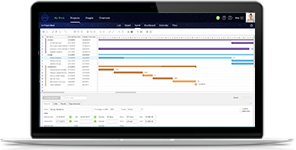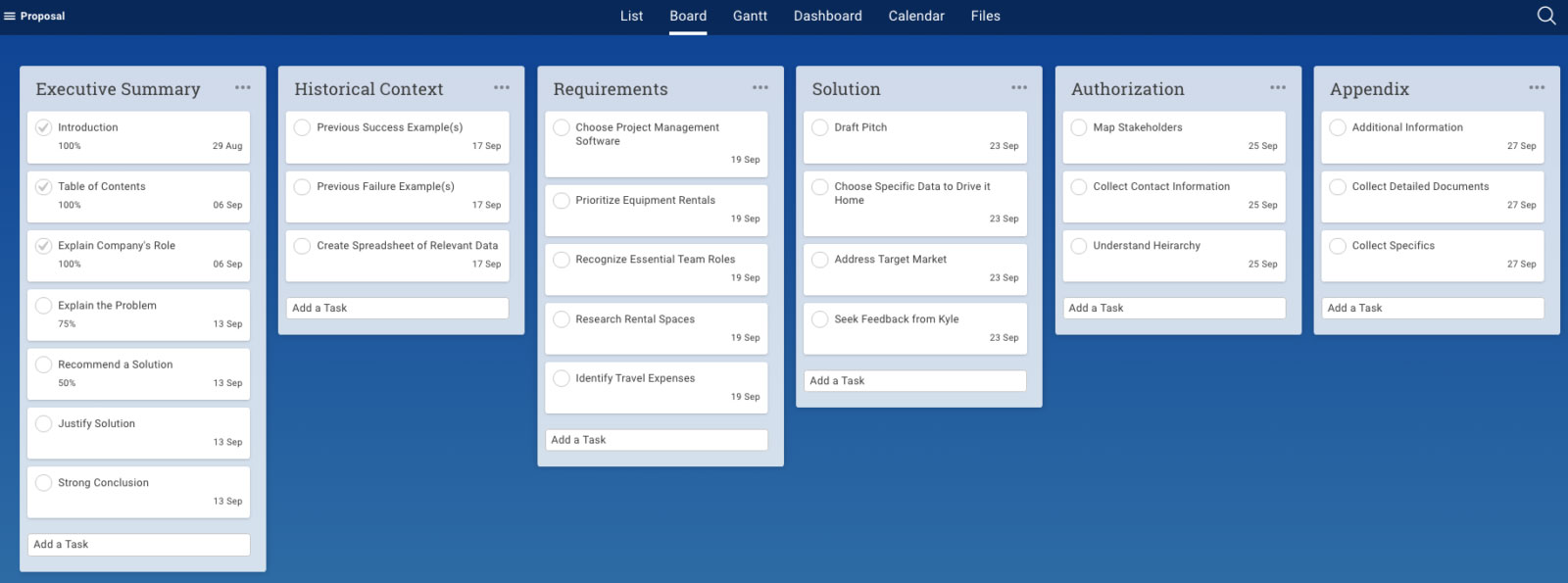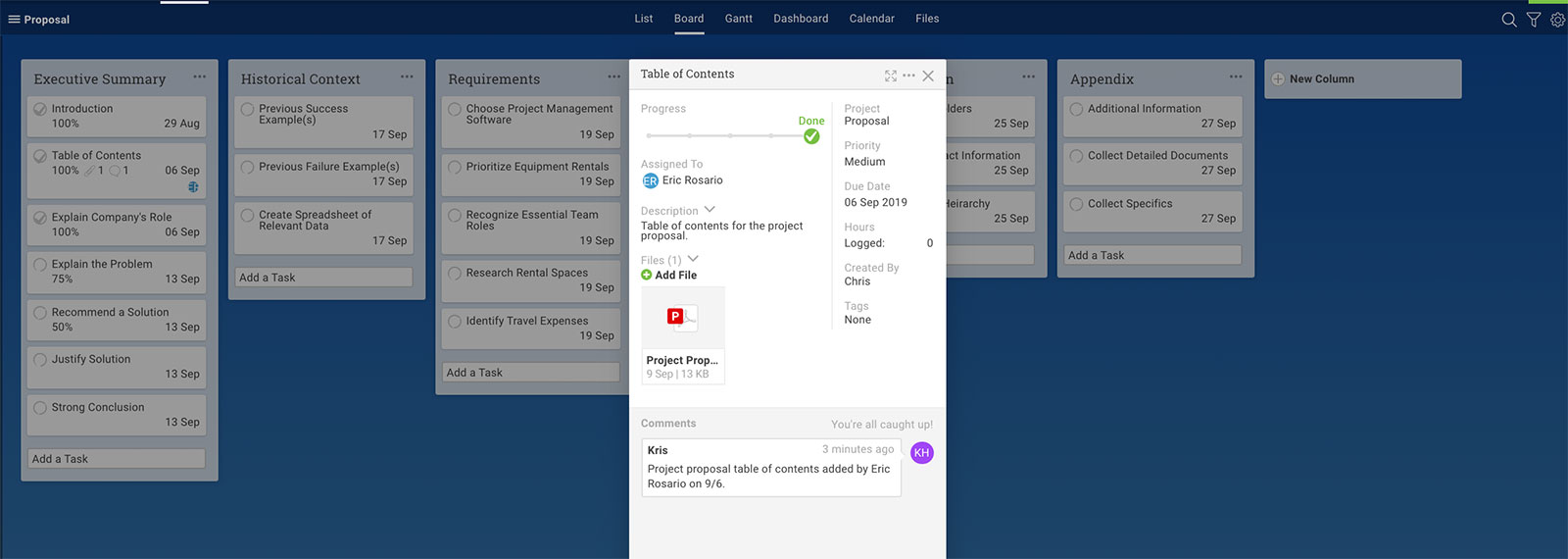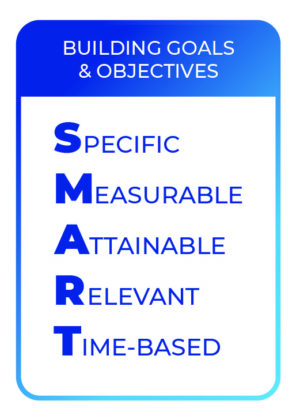How To Create A Software Project Proposal
How to Write a Project Proposal (Steps & Template Included)
ProjectManager.com 

Make Your Project Proposal a Reality. With ProjectManager's management tools, you'll be able to ensure your project proposal is executed exactly how you want it.
Get a 30-Day Free Trial
What is a Project Proposal?
A project proposal is a project management document that's used to define the objectives and requirements of a project. It helps organizations and external project stakeholders agree on an initial project planning framework.
The main purpose of a project proposal is to get buy-in from decision-makers. That's why a project proposal outlines your project's core value proposition. It sells value to both internal and external project stakeholders. The intent of the proposal is to grab stakeholder and project sponsor attention. Once you have people's attention, the next step is getting them excited about the project summary.
Getting into the heads of the audience you are writing the project proposal for is vital: you need to think like the project's stakeholders to deliver a proposal that meets their needs.
We have created a free project proposal template for Word to help structure documents, so you don't have to remember the process each time.
Types of Project Proposals
In terms of types of project proposals, you can have one that is formally or informally solicited or a continuation. There can also be renewal and supplemental proposals. Here's a brief description of each of them.
- Solicited Project Proposal: A solicited project proposal is sent as a response to a request for proposal (RFP). Here you'll need to adhere to the RFP guidelines of the project owner.
- Unsolicited Project Proposal: You can send project proposals without having received a request for proposal. This can happen in open bids for construction projects, where a project owner receives unsolicited project proposals from many contractors.
- Informal Project Proposal: This type of project proposal is created when a client asks for an informal proposal, without an RFP.
- Renewal Project Proposal: You can use a renewal project proposal when you are reaching out to past customers. The advantage is that you can highlight past positive results and future benefits.
- Continuation Project Proposal: Sent to investors and stakeholders to communicate project progress.
- Supplemental Project Proposal: This proposal is sent to investors to ask for additional resources during the project execution phase.
How to Write a Project Proposal
There are several key operational and strategic questions to consider, including:
- Triple Constraint: How can we address the triple constraint of project scope, schedule and cost?
- Core Problem: What is the core problem we're trying to solve?
- Resources: What resources will be available?
- Timeline: What project timeline are we working within?
- Budget: What project budget do we have to work with? How does this affect our goal setting?
- Strategic Goals: What are the strategic goals of our client, and how does our proposal align with those goals?
- Responsible Parties: Who are the people responsible for the project? What are their goals and motivations?
- Client Benefit: How will the client benefit from the completion of our project? What is their primary goal?
- Project Deliverables & Success: How will success of the project be measured? What deliverables do our stakeholders expect to see at closure?
Once you've answered these questions, you can write a project proposal. All project proposals have six elements which construct the proposal's foundation. Let's take a look at a project proposal example.
Sample Project Proposal Outline
These six elements are the foundation of a well-constructed project proposal outline:
Executive Summary
The executive summary provides a quick overview of the main elements of your project proposal, such as your project background, project objectives, project deliverables, among other things. The goal is to capture the attention of your audience and get them excited about the project you're proposing. It's essentially the "elevator pitch" for the project life cycle. It should be short and to the point.
The executive summary should be descriptive, and paint a picture of what project success looks like for the client. Most importantly, it should motivate the project client; after all, the goal is getting them to sign on the dotted line to get the project moving!
Project Background
The project background is a one-page section of your project proposal that explains the problem that your project will solve. You should explain when this issue started, its current state and how your project will be the ideal solution.
- History: The history section outlines previously successful projects. It also outlines those that could have run more smoothly. By doing so, this section establishes precedents. Namely, how the next project can be more effective using information from previous projects.
- Solution: The solution section addresses how your project will solve the client's problem. Accordingly, this section includes any project management techniques, skills and procedures your team will use to work efficiently.
Project Approach
Your project approach defines the project management methodology, tools and governance for your project. In simple terms, it allows project managers to explain to stakeholders how the project will be planned, executed and controlled successfully.
- Requirements: Requirements are the items, materials and resources needed for the project. This section should cover both internal and external needs.
- Authorization: This section covers who the decision-makers are on the project team. It also covers which stakeholders have sign-off authority on the client's side.
- Project Scope: The project scope refers to all the work that will be executed. It defines the work items, work packages and deliverables that will be delivered during the execution phase of your project life cycle. It's important to use a work breakdown structure (WBS) to define your tasks, subtasks and prioritize them.
- Project Resources: Resources are critical for the execution of your project. The project proposal briefly describes what resources are needed and how they'll be used. Later, during the planning phase, you'll need to create a resource management plan that will be an important element of your project plan.
- Project Timeline: Once you've defined your project scope, you'll need to estimate the duration of each task to create a project timeline. Later during the project planning phase, you'll need to create a schedule baseline, which estimates the total length of your project. Once the project starts, you'll compare your actual project schedule to the schedule baseline to monitor progress.
- Project Budget: All the resources that you'll need for your project will have a price tag. That's why you need to estimate those costs and create a project budget. The project budget will need to cover all your project expenses, and as a project manager, you'll need to make sure that you adhere to it.
- Financial Statements: If you want to convince internal stakeholders and external investors, you'll need to show them what are the financial benefits that your project could bring to their organization. You can use a cost benefit analysis and projected financial statements to demonstrate why your project is profitable.
- Appendix: Information not included in the project proposal is part of the appendix. It's where many of the more interesting details of a project are located. Also, it's where team members and stakeholders can do a deep dive to learn more.
Free Project Proposal Template
While a project proposal template has limitations, it's a good place to start writing your project proposal. Try our free project proposal template for Word.
Project Proposal Tips
Whatever project proposal you're working on, there are a few tips that apply as best practices for all. While above we suggested a project proposal template that would have a table of contents, meaning it would be many pages long, the best-case scenario is keeping the proposal to one or two pages max. Remember, you're trying to win over stakeholders, not bore them.
Speaking of project stakeholders, do the research. You want to address the right ones. There's no point in doing all the work necessary to write a great proposal only to have it directed to the wrong target audience. Whoever is going to read it, though, they should be able to comprehend the proposal. Keep the language simple and direct.
When it comes to writing, get a professional. Even a business document like a project proposal, business case or executive summary will suffer if it's poorly constructed or has typos. If you don't want to hire a professional business writer, make sure you get someone on your project team to copy, edit and proof the document. The more eyes on it, the less likely mistakes will make it to the final edition.
While you want to keep the proposal short and sweet, it helps to sweeten the pot by adding customer testimonials to the attachments. Nothing sells a project plan better than a customer base looking for your product or service.
Using Kanban Boards to Plan a Project Proposal
ProjectManager allows you to plan proposals within our software. You can update tasks for the project proposal to signify where things stand, and what's left to be done. The columns allow you to organize your proposal by section, creating a work breakdown structure (WBS) of sorts.
Follow along with this video to methodically go through all the steps of your proposal, ensuring that every detail is covered. After watching, read on to review the key aspects.

When building a project proposal, it's vital to remember your target audience. Your audience includes those who are excited about the project, and see completion as a gain for their organization. Conversely, others in your audience will see the project as a pain, and something to which they aren't looking forward. To keep both parties satisfied, it's essential to keep language factual and concise.
Our kanban boards help you think through that language and collaborate on it effectively with other team members, if necessary. Each card shows the percentage completed so everyone in the project management team is aware of the work done, and what's left to be done.

As you can see from the kanban board above, work has begun on the Executive Summary. The Introduction, Table of Contents and Company Role sections are completed, and there's a good start on the Explain the Problem and Recommend a Solution task.
The screenshot below shows how you can add files to a kanban card, and leave a comment about the file that was added. In this case, Eric Rosario added the Project Proposal Table of Contents, and Kris left a note it had been added on 9/6:

A PDF is then attached to the card, and everyone added to the task receives an email notifying them of the change. This same process can be used throughout the life-cycle of the project to keep the team updated, collaborating, and producing a first-class project proposal.
Developing SMART Goals for Your Project Proposal

The best mindset when developing goals and objectives for your project proposal is to use the SMART system:
- Specific – Make sure your goals and objectives are clear, concise and specific to the task at hand.
- Measurable – Make sure your goals and objectives are measurable so it's obvious to see when things are on track and going well, and conversely, when things are off track and issues need to be addressed. Measurable goals make it easy to develop the milestones you'll use to track the progress of the project and identify a reasonable date for completion and/or closure.
- Attainable – It's important every project has a "reach" goal. Hitting this goal would mean an outstanding project that goes well above and beyond expectations. However, it's important the project's core goal is attainable, so morale stays high and the job gets done with time and resources to spare.
- Relevant – Make sure all of your goals are directly relevant to the project and address the scope within which you're working.
- Time-Based – Timelines and specific dates should be at the core of all goals and objectives. This helps keep the project on track and ensures all project team members can manage the work that's ahead of them.
Building a project proposal takes time and careful consideration.
The time spent is worth it, however, when you win that next big project!
Project proposals are just the first step in the project planning process. Once your project is approved, you'll have to solidify the plan, allocate and manage resources, monitor the project, and finally hand in your deliverables. This process requires a flexible, dynamic and robust project management software package. ProjectManager is a cloud-based project management software that helps all your team members collaborate and manage this process in real-time. Try our award-winning software with this free 30-day trial.
Related Posts
How To Create A Software Project Proposal
Source: https://www.projectmanager.com/blog/how-to-create-a-project-proposal
Posted by: kennedyliaboarpood.blogspot.com

0 Response to "How To Create A Software Project Proposal"
Post a Comment